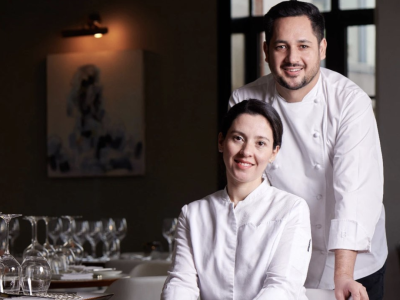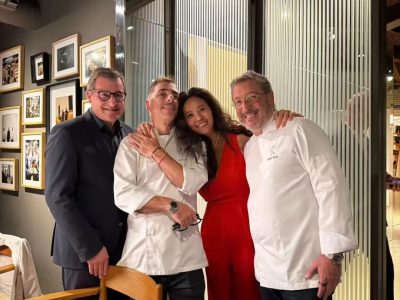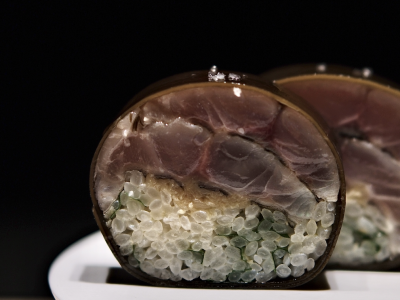SENsation —Samuel Lee’s Chinese Bistro
Surely someone should have thought of this sooner, shouldn’t they?
A Chinese bistro in Paris—not unlike the many French ones that line the city’s streets, but serving Chinese fare instead of French. Casual and easy-going, it’s a place where food and wine are companions, not competitors. No banquet-style extravagance, no wedding feast dishes.It’s a style of dining that aligns with how Parisians like to eat out: informal, flavorful, and woven into the rhythm of everyday life.
Located in the increasingly bistro-rich 11th arrondissement, SENsation sits next to the long-establishedServan, and faces the well-known gourmet grocer Julhès. The entire rue Saint-Maur and its surrounding alleys are a lively enclave of Parisian life, filled with bars, fromageries, and patisseries that attract a youthful, energetic crowd.
The interior design avoids tired clichés—no garish reds, no dragons and phoenixes in calligraphy. Instead, the floor is worn red brick, the walls stripped down to stone and plaster, complemented by marble tables that look like ink-washed stone, smooth dark-wood chairs, and layers of soft lighting that lend warmth and depth. A few lanterns shaped like miniature pavilions dangle playfully from the ceiling, adding a whimsical twist.
The walls aren’t bare: there are prints of ancient dining scenes, and lines from the Tang poet Li Bai: “Let us drink, stop not the cups. Life must be enjoyed when fortune smiles; do not let the golden goblet face the moon in vain”. This perfectly encapsulates the restaurant’s spirit—pleasure in the present, in good wine and good food. Modern meets antique, refinement meets rustic charm—there is an enduring elegance here.
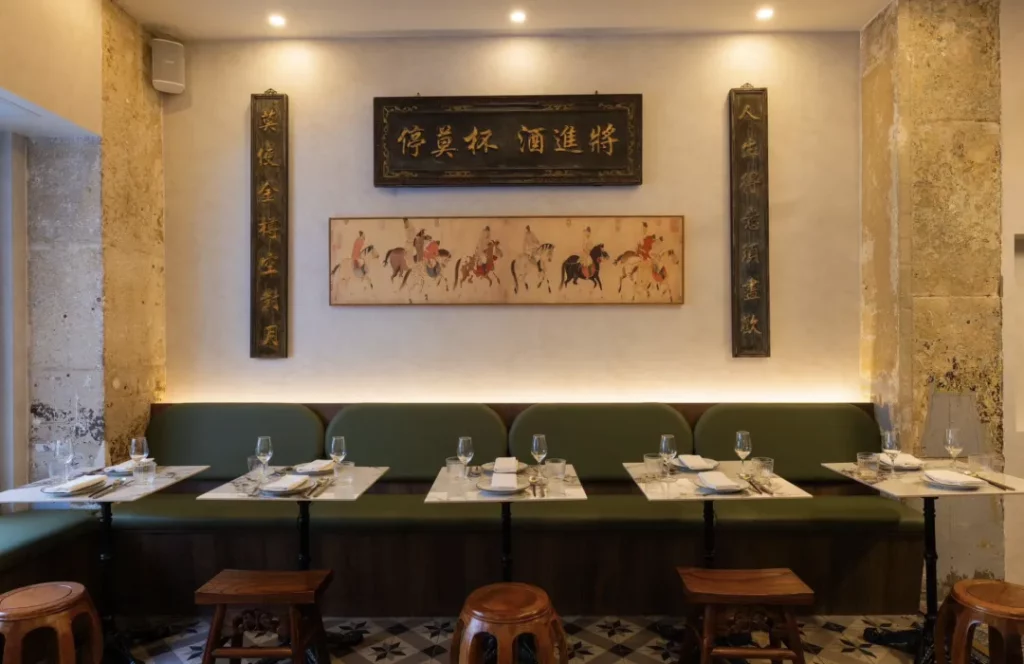
On the menu: golden kimchi, buri sashimi, Chaozhou-style marinated oysters, shrimp siu mai, spicy fried shrimp balls, vegetable spring rolls, and turnip cake with Iberico ham. There’s also a five-course set menu, and a whole roast duck available by reservation.
Chef Lee’s Chinese cuisine carries a trace of European DNA. The vegetable spring rolls are topped with shavings of 15-month Comté cheese; the turnip cake is crowned with 36-month Iberico ham; the char siu is flambéed with Cognac from the house of Lehraud.
The handmade siu mai and shrimp balls are everything they should be—crispy when expected, tender and bouncy where needed. Even in these small bites, there’s meticulous attention to detail.
The roast duck is said to blend Cantonese-style roasting with crispy-skinnedyoulinji technique. Whole ducks are air-dried in a custom drying cabinet, yielding crisp, fragrant skin.
Desserts, too, are beautiful hybrids: oolong custard tart with black sesame ice cream, and a pine-apple reduction withpoivre de Sichuan meringue.
That evening, the restaurant was fully booked.
Many guests sported a distinct personal style—there was a fashionable energy in the air.
My takeaway from the meal was this: SENsation fills two important gaps in the ecosystem of Chinese cuisine in Paris.
First, beyond high-end destinations like LiLi at the Peninsula, Shang Palace at Shangri-La, or group-run luxury brands like Imperial Treasure, most Chinese restaurants in Paris are either cheap and heavy-handed or rely on questionable ingredients and seasoning.
Rare are those that are refined yet unpretentious, offering well-crafted, comforting food in a bistro setting.
Second, the wine. Chinese restaurants have historically ignored wine, as if it simply doesn’t matter. A thoughtful wine list has existed only in the aforementioned upscale establishments—until now. SENsation’s wine selection surpasses even many French bistros, with something for every budget—from €30–40 bottles of small-scale organic natural wines to prestigious grands crus in the thousands.
Most importantly: there is a chef who truly cooks. His personal style and the warmth of his team are palpable in every bite. That human presence is something most Chinese restaurants lack.
Of course, this doesn’t mean SENsation is perfect. Like any new restaurant testing the waters, there’s still fine-tuning ahead. Should the char siu be served with extra sauce to appease French palates? The shiitake “minced meat” rice uses Thai jasmine rice, which somehow feels off. And personally, the duck broth was a little too heavy on the pepper.
Still, one month into its opening—with not a single image on its official Instagram—the restaurant is already whispered about in foodie circles as a secret gem. I was late to the game: reservations are already hard to come by.
Walking out into the still-busyrue Saint-Maur, I looked up at the moon and thought of that line—“Let us drink, stop not the cups.” To have a place in Paris that serves refined, modest Chinese dishes paired with a fine glass of wine—SENsation is truly one of a kind.
Epicure — As Sumptuous As Ever
For the first course, I choseLangoustine.
This marked the third time I encounteredlangoustines recently—after La Scène and L'Ambroisie.
Some translatelangoustine as “small lobster,” but only when it reaches the regal scale served here at Epicure does the comparison feel apt. I’ve always preferredlangoustines over lobster or king prawns—both for their sweeter, subtler flavor and their uniquely satisfying texture.At this elite level, the sweetness of thelangoustine is more delicate and resonant, with a lingering elegance. The texture offers a clean snap that is springy, yet not rubbery—a gentle crunch that is immensely pleasing.
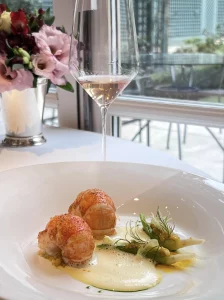
Presented curled like orbs on the plate, the two Scottish langoustines hinted at their generous size. Slicing into one revealed flesh much thicker than usual. A single bite was enough to reveal their captivating marine essence.
The server poured a citrus-fennel sauce over the plate, keeping the rest warm in a silver ladle heated by a small candle. The sauce was exquisitely refined—la quintessence de la sauce française (the very pinnacle of French sauce-making). One could sip it on its own and be completely entranced, intoxicated by its elegance. Paired with the natural sweetness of thelangoustine, the sauce revealed its fine balance and deep base. It was more than accompaniment—it was another protagonist on the plate. Like a dazzling gem set into an opulent gown.
Compared with thelangoustine dishes at L’Ambroisie and La Scène, each had its own triumphant merits—there was no clear hierarchy. Even against last year’s signature creation by former chef Eric Fréchon—the langoustine aux agrumes (langoustine with citrus), which graced the cover of a major culinary magazine—I would argue that Arnaud Faye’s interpretation holds a slight edge.
But such comparisons are battles among immortals—impossible to adjudicate and, in truth, of little meaning. It often comes down to the subjective preferences of the diner. This, I believe, is the most magical aspect of haute French cuisine: even with the same premium ingredient, different chefs can compose stunningly distinct masterpieces.
The restaurant’s famedpoularde en vessie (chicken cooked in a pig’s bladder) was no longer on the menu, replaced by roasted poulet de Bresse (Bresse chicken).
Still, it was served in two parts: first the breast, then the leg. The breast was served with crisp skin, perfectly cooked, the flesh tender and pristine. A hint of salt lifted the natural flavor of the chicken—it was a lesson in restraint and refinement. In contrast, the side garnishes—two green spheres filled with offal, freshwater crayfish with sauce, mushrooms—felt almost unnecessary.
The second service featured the leg, cut into small pieces with skin on, served with chicken sausage and a roasted chicken jus enhanced with crayfish. The sausage was excellent; the sauce, however, leaned too salty.
The former Japanese pastry chef Yu Tanaka has since departed. In his place is the lesser-known Maxence Barbot, though his résumé is studded with glittering addresses—Shangri-La Paris, Hôtel Plaza Athénée, Four Seasons…
Still, little seems to have changed. Tanaka’s legendary vanilla dessert remains—a creation that may just be the world’s finestglace à la vanille (vanilla ice cream). The black truffle and hazelnut soufflé feuilleté resembled an alien blossom: enigmatic, bewitching, and utterly sublime. It has been a long time since a dessert moved me this deeply.
Our table faced the garden through tall windows. Even under gray skies, the room was bright and spacious. The gleaming marble floors, the white tablecloths, the red floral drapes framing the verdant garden beyond—it was all still there, as grand as ever.
Indeed, Epicure remains a monument to Parisian luxury.
But those who follow the Paris dining scene will know that Eric Fréchon, the chef who held three Michelin stars for 15 years, stepped down last April—a move that sent shockwaves through the culinary world. Rumors still swirl around the reasons for his departure.
The new executive chef is Arnaud Faye, 47 years old, and long considered a rising star in the Michelin ranks.
His name was already familiar to me. Many years ago, when he first emerged at Auberge du Jeu de Paume in Chantilly, I visited and was dazzled by his finesse. The restaurant earned a Michelin star the very next year.
His reputation soared with his talent. Not long after, he was recruited byLa Chèvre d'Or, the famed restaurant in the cliffside town of Èze on the Côte d’Azur. Supported by the resources of a grand hotel, he soon claimed two stars. He once shared his philosophy of haute cuisine:"True luxury isn’t getting whatever you want, whenever you want. It’s knowing how to wait for nature to offer her best—at the right moment."
This meal unmistakably displayed his signature: precision, depth, restraint. The Le Bristol mantle fits him with ease.
I believe when the Michelin Guide announces its new stars in March,Epicure will retain all three under his leadership.
One last note: the vegetable menu is beautifully crafted. Rarely do I feel tempted by vegetarian offerings in such a setting——
this one, however, I’d consider for next time.
Le Cinq
It had been many years since I last visited the three-star restaurant Le Cinq, located in the Four Seasons Hotel.
Le Cinq more than lives up to its reputation as one of the most beautiful dining rooms in Paris. The violet orchids adorning the grand salon create an atmosphere that is elegant without ever becoming ostentatious. I've always felt that, among all the Parisian palaces, the floral arrangements at the Four Seasons are the most majestic and refined.
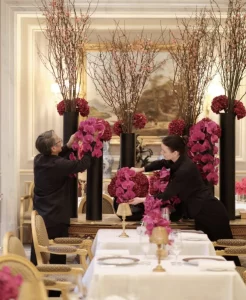
The tasting menu I selected brought together several of Chef Christian Le Squer’s signature creations. The soupe de l’oignon gratiné (gratinated onion soup) is a dish he developed after arriving at the Four Seasons, while the famous dessert pamplemousse croustillant (crispy grapefruit) dates back to his time at Ledoyen.
Each course was executed with exemplary precision: the langoustine (Norway lobster) cooked to absolute perfection; the sauce accompanying the bar (sea bass) rich, textured, and deeply flavorful; the plating of the pamplemousse croustillant as exacting as a work of art. Every element reflected a kitchen team operating with fluidity and flawless control.
We ordered two bottles of wine: a magnum of white Domaine Jean-Louis Chave L’Hermitage 2016, and a magnum of red Domaine Jamet Côte-Rôtie 2005.
Both were in excellent condition, though the latter would have benefited from a few more years of aging—or at least from greater aeration. Regardless, it was an exceptionally enjoyable dining experience—not only due to the finesse of the cuisine and the quality of the wines, but also thanks to the remarkable, professional service provided by the staff at the Four Seasons.
Photo:instagram@lecinqparis、chungtaohsieh、ericeréchon/michelinguide.com/Facebook@巴黎玩家謝忠道
Author:谢忠道

